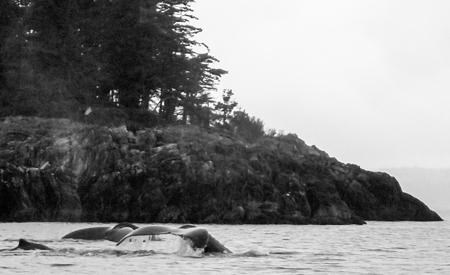It has been an outstanding year for humpback sightings, according to local watchers, with many of the ocean-going mammals spotted from shore or BC Ferries.
“It’s amazing,” said local nature photographer Steven Grover. “I lived here years ago when I was in high school and never saw any whales at all.”
Grover has spent many days out on a boat this year, photographing whales and trying to catch the occasional fish. One of his favourite whale-spotting sights is around Blubber Bay, a former whaling station on Texada Island.
“It has been an unprecedented year for humpbacks,” said Wild Ocean Whale Society founder Susan MacKay who tracks whales in the strait. “I’ve seen more whales in the area than we’ve had for 20 years.”
According to Department of Fisheries and Oceans Canada (DFO) senior research scientist Ian Perry, the increased number of whale sightings in the Strait of Georgia this year is a strong sign that whales are recovering after decades of whaling.
Other than Texada, whaling stations in the strait were open between 1908 and 1967 on Vancouver Island, Hornby Island and Cortes Islands.
“Humpbacks are recovering,” said Perry. “What we are seeing is a spillover and recolonization of humpbacks into their traditional areas.”
According to Perry, humpbacks are increasing at a rate of about four per cent annually. A reasonable rate given their longevity, he said.
“It takes humpbacks a while to recover,” he said. “These are long-lived animals that don’t have many youngsters.”
Based on historical whaling data, Perry estimated there were about 4,000 humpbacks along the BC Coast 100 years ago. Even after whaling reduced the number of humpbacks in the area, the population remains stable, he said.
Perry said humpback numbers are still strong because of the increasing availability of food in the Strait of Georgia. In particular, there is a large system of euphasiids, or krill in the area. Krill are tiny, bottom-dwelling crustaceans found in the strait.
During feeding season humpback whales can consume many tonnes of krill each day; filtering them through their baleen, a system of long, thin strands hanging from their upper jaws.
Although approximately 20 species of krill can be found in BC, the species euphasia pacifica accounts for the bulk of what is found in the Strait of Georgia where trawl boats have plied a commercial fishery since 1983. Krill is used as fish food in aquaculture and pet industries.
Nevertheless, Perry noted an abundance of krill and numbers have increased since 2004.
According to DFO, BCs annual krill harvest is limited to 500 tonnes annually with 16 trawl boats licensed last year, down from 18 in 2013 and 2012.
“The krill fishery has been kept very small,” said Perry. “We want to make sure as many as possible are available for fish and marine mammal species to feed on.”
The krill fishery in the Strait of Georgia is tracked by dockside monitoring and will be open until the quota is achieved or December 31, whichever comes first.



